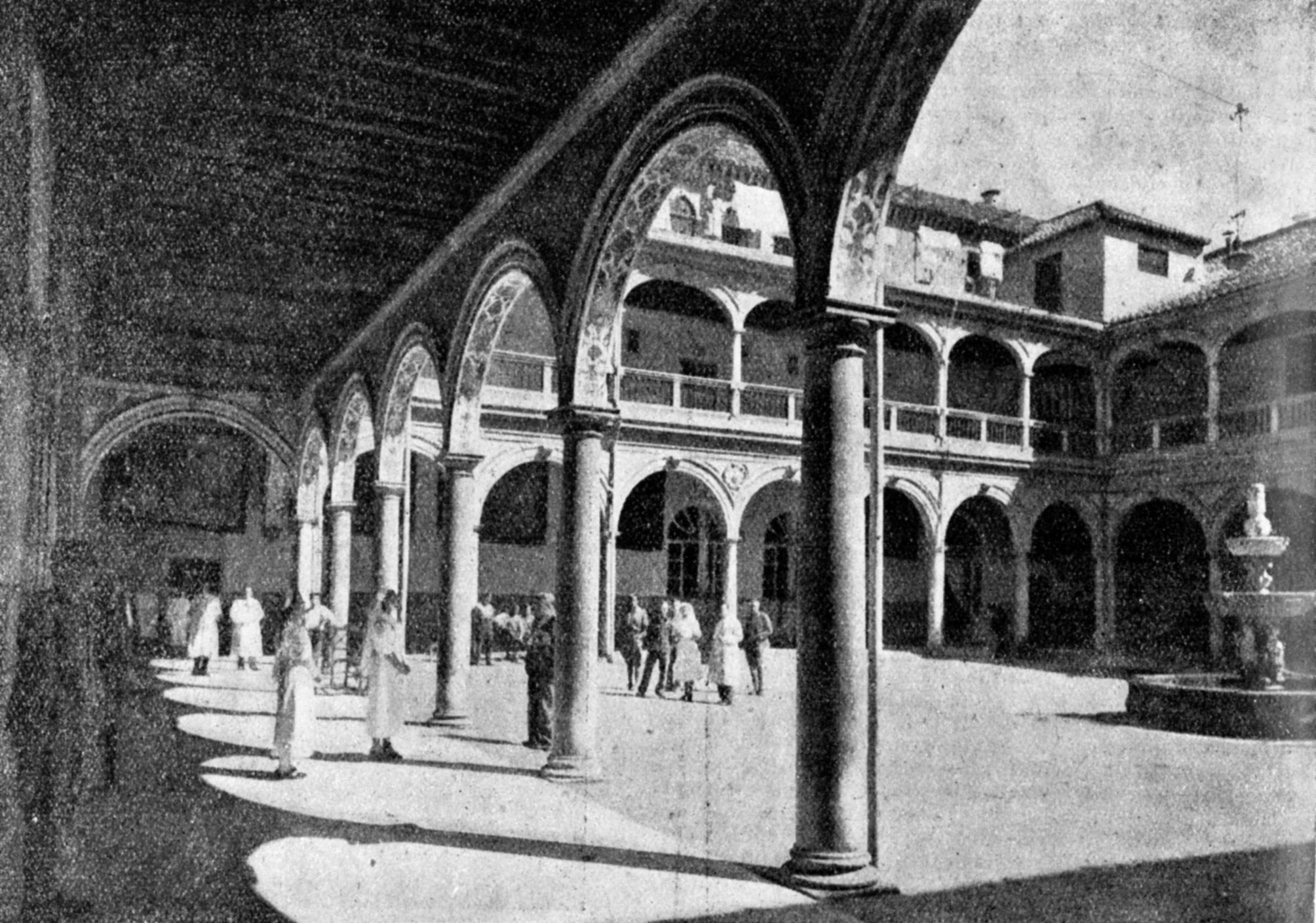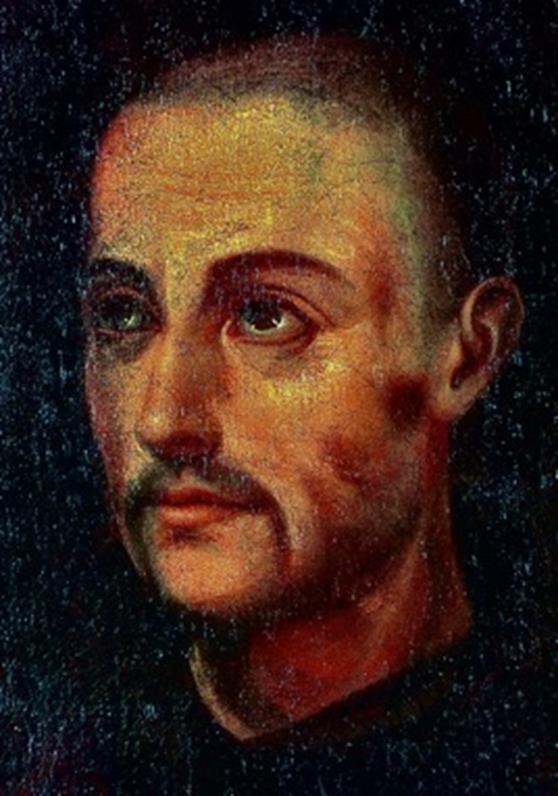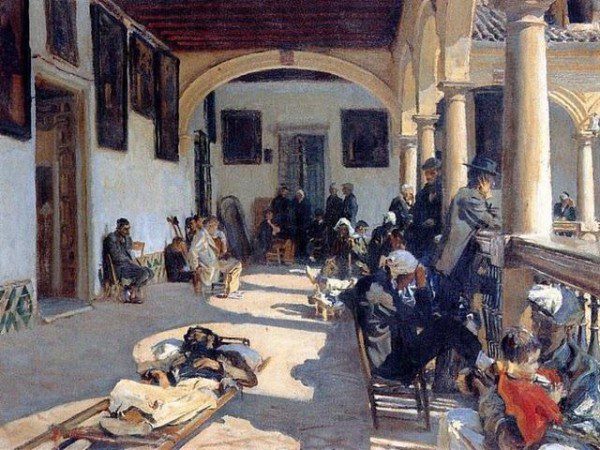Nicolas Roberto Robles
Badajoz, Spain

The first biography of St. John of God was written by Francisco de Castro and is the source for most of what we know about his life. He was born João Duarte Cidade in 1495 near Évora, Portugal, in Montemor-o-Novo, a small city halfway on the road from Lisbon to Spain. At age eight he left his home to follow a mendicant monk, begging their way from village to village until he fell sick. Adopted by the man who nursed him back to health, John worked as a shepherd in the mountains until he was 27. Then he took off to join the Spanish army in the war against France. As a soldier, he took part in the savage behavior that his comrades enjoyed. One day, he was thrown from a stolen horse near the French lines. Afraid that he would be captured or killed, he vowed on impulse to change his life if he got back to the Spanish camp alive. His comrades disliked his new behavior and his urgings that they abandon their bad behavior. He was falsely sued for leaving his post and sentenced to be hanged. He was reprieved at the last minute and thrown out of the army after being beaten.
He went back to Spain and again became a shepherd. At 38 he decided to go to Africa to ransom Christian captives. He set off for Gibraltar and then went to Ceuta, which in those times was a Portuguese city in the north of Africa. After two years, he returned to Spain and became a book peddler, traveling from town to town selling religious books and holy cards. A vision at age 48 took him to Granada where he went on selling books from a little shop.
Upon hearing a sermon on repentance from the famous preacher St. John of Avila, John felt overcome by the thought of his sins. He rushed back to his shop, tore up any secular books that he had, and gave away all of his religious books and all of his money. People thought the little bookseller had gone mad as he ran about town weeping in torn clothes. He became the butt of louts and hooligans who would follow him on the street, egging him on and throwing mud and filth at him. Two respectable gentlemen of the city took pity upon him and led him away from the rabble, bringing him to the Royal Hospital where the insane were put away for treatment. The cures they used for such cases consisted of flogging and placing the afflicted person into a dismal dungeon tied up by the hands and feet. John of Avila came to visit him there and told him his penance had gone on long enough and ordered him moved to a better part of the hospital. He at once got up and began to help the other sick people around him. The hospital workers were glad to have his unpaid nursing help and were not happy to release him when one day he announced that he was going to start his own hospital where the sick and poor would receive proper help.

Firstly he decided to make a pilgrimage to the shrine of Our Lady of Guadalupe in Extremadura (Spain), a reputed medicine and pharmacy school in those days, far from Granada but near to the place where he had been a shepherd. Going back to Granada he started to bring food and comfort to the poor people living in abandoned buildings and under bridges. He went and spoke to some devout people who had helped him before and with their support and his own enthusiasm, he was able to rent a house near the fish market close to the Plaza Bibarrambla, in the Lucena street. Every day, after he begged for money for beds, food, and medicine, he went out in the streets again and carried his ill patients back on his shoulders. Once there, he cleaned them, dressed their wounds, and mended their clothes at night while he prayed. He used his old experience as a peddler to beg alms, crying through the streets in his peddler’s voice, “Do good to yourselves! For the love of God, Brothers, do good!” John of God’s—as the archbishop of Granada called him for the Eternity—charity became so famous that the house could no longer accommodate the great number of poor people arriving there. So some respectable leading citizens approached him about purchasing a larger house to accommodate them all. They bought a place in the Calle de los Gomeles which used to be a monastery for Carmelite nuns. The building of a larger hospital—nowadays called St. John of God’s Hospital—was soon started but he could not see it finished.
John died of the same impulsive love that had guided his whole life. He was ill himself when he heard that a flood was bringing precious driftwood near the town, one of the resources that he used to earn money for attending to the poor. He jumped out of bed to gather the wood from the raging Genil river. Then when one of his companions fell into the river, John jumped in after him without thought of his illness or safety. He failed to save the boy and caught pneumonia. He died on March 8, 1550, his fifty-fifth birthday. St. John of God was canonized by Pope Alexander VIII in 1691 and was declared heavenly patron of the dying and of all the hospitals by Pope Leo XIII in 1898. St. John of God is also recognized as the patron saint of nurses in Catholicism.
The charity of St. John of God was destined to be perpetuated among his brethren, whom he had formed by his lessons and example. His first companion Anton Martin was chosen to succeed him as superior of the order. Thanks to the generosity of King Philip II, a hospital was founded in Madrid at the place currently named Anton Martin square, another at Cordova, and several others in various Spanish towns. As a matter of fact, the Hospital Gregorio Marañ of Madrid is currently placed in the location of the ancient St. John of God Hospital of Madrid, a second foundation after Anton Martin’s first one.

Pope St. Pius V approved the Order of the Hospitallers Brothers in 1572 under the rule of St. Augustine. Today the Brothers undergo a special course of training in order to fit them for carrying out their various works of charity, to which they devote their lives. In some provinces a few of them are even graduates in medicine, surgery, and chemistry. After the example of their founder, they seek their own sanctification and their patients’ spiritual and corporal welfare. To the three solemn vows of religion they add a fourth, of serving the sick for life in their hospitals. They also perform the usual duties and pious exercises of the religious life.
The order spread rapidly into the other countries of Europe, and even into the distant colonies as far as the Philippines Islands. In 1584, Pope Gregory XIII called some of the Brothers to Rome and gave them the Hospital of St. John Calybita, which then became the mother-house of the whole order: Brother Pietro Soriano was appointed first superior. Brother Sebastiano Arias founded the Hospital of Our Lady at Naples and the famous hospital of Milan. The first hospital of the order in France was founded in Paris, in 1601, by Queen Marie de Medici. Afterword several new hospitals were raised in Germany, Belgium, Austria, and other east European countries.
In the stormy days of the French Revolution the Hospitallers Brothers were expelled from the forty hospitals in France where they were caring for more than four thousand patients. A similar situation occurred in Spain in 1833 after the Mendizabal’s liberal government ordered the expulsion of the Brothers from its hospitals all over the country. But since then, some large new hospitals have been established, and recently the local government of Andalusia has restituted the original St. John of God Hospital in Granada to the Hospitaller Order. Nevertheless, the Hospitaller Brothers had previously built a new hospital in the adjacent terrain. This new one was called “San Rafael” (which translates to “God’s Medicine”) who was the favorite saint of St. John of God. Today the order is governed by a prior general, who resides in Rome; it is now divided into eleven provinces, with 102 hospitals in 55 countries, more than 1,500 Brothers, and about 13,000 beds all over the world. The last foundation has been a palliative care setting in China.
Although nursing ill people has usually been an activity played by monks and sisters in Benedictine and other religious monasteries, the Hospitaller Order was the first one specifically founded with the aim of nursing and serving the sick for life in their own hospitals (not religious buildings) and the first to establish a hospital network which reached as far as did the Catholic faith.
NICOLAS ROBERTO ROBLES, YFO, was fellow of the Nephrology Department of the Hospital Gregorio Marañón, Madrid. Currently, he is a Senior Consultant and Head of the Hypertension Unit at the Hospital Infanta Cristina, Badajoz. He is an Associate Professor of Nephrology (Universidad de Extremadura). He was National Coordinator EDTA-ERA Patient’s Registry and Member of the Sociedad Española de Nefrologia Registry Committee. He also works as the Cardiovascular Risk Chair’s Associate Director at the University of Salamanca’s Medicine School.
Highlighted in Frontispiece Volume 9, Issue 2 – Spring 2017

Leave a Reply